2012 CCOE Award Recipients
Division of Pain Medicine, Stanford University
Palo Alto, CA
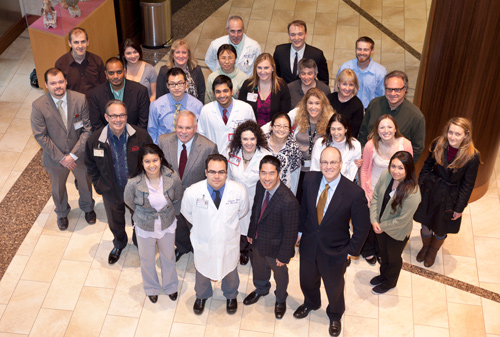 A second round of congratulations is in order for the Stanford University Pain Management Center, which received an APS CCOE in Pain Management Award in 2008. The division vigorously pursues a model of comprehensive interdisciplinary clinical care integrated with its research vision: “Predict, Prevent, and Alleviate Pain.”
A second round of congratulations is in order for the Stanford University Pain Management Center, which received an APS CCOE in Pain Management Award in 2008. The division vigorously pursues a model of comprehensive interdisciplinary clinical care integrated with its research vision: “Predict, Prevent, and Alleviate Pain.”
Situated in the San Francisco Bay Area, the Division’s diverse faculty and staff serve patients from diverse racial, cultural, and socioeconomic backgrounds.
The Pain Division specialists offer medical, pharmacological, procedural, psychological, physical/occupational therapy, and complementary medicine interventions in their new 9,000-sq-ft outpatient Center and their dedicated inpatient chronic pain unit. Core faculty include specialists from anesthesiology, neurology, physiatry, internal medicine, psychology, and addiction medicine–all trained in pain management.
The Division employs a biopsychosocial approach to evaluating and treating patients experiencing complex acute, chronic, and cancer pain conditions. The faculty performs translational and clinical research, applying results to continuously improve patient outcomes. For example, the Division has recently translated its low-dose naltrexone study into a cost-effective treatment for fibromyalgia. Additionally, the Division was recently awarded an National Institutes of Health (NIH) P01 Center grant to investigate the mechanisms of “old” and “new” mind-body therapies for chronic low back pain including: CBT, MBSR, acupuncture and real-time fMRI neurofeedback.
The Division continues to develop the next generation of translational research and clinical investigators, as evidenced by a strong multidisciplinary Pain Fellowship and trainees’ receipt of multiple NIH K23, T32, and K99/R00 awards.
In summary, one CCOE award reviewer stated, “The program is a model of sustained excellence and innovation as it continues to expand the breadth of services via formal program development efforts that meet the needs of patients with specific, difficult-to-manage pain disorders…a range of other innovations to promote coordination of care is exciting to see.”
Fairview Pain Management Center, University of Minnesota Medical Center
Minneapolis, MN
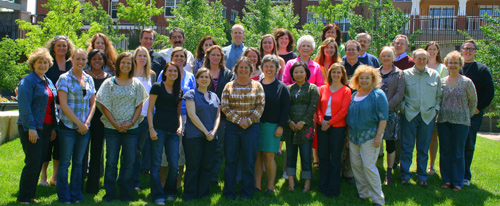 The Fairview Pain Management Center (FPMC), another second-time CCOE Award Recipient (first awarded in 2008), has completely reinvented its care model in recent years. The program, which serves more than 6,000 patients annually (about 4,800 on an outpatient basis), now collaborates with primary care clinics by sending multidisciplinary pain teams to work on site with primary care providers to offer assessment, management, and physician education at the patient’s home clinic (healthcare home). Despite financial challenges, Fairview Pain Management Center (FPMC) has maintained and expanded its multidisciplinary model while providing outreach services to primary care clinics. Team members consist of neurologists, physiatrists, interventionalists, internists, psychologists, physical therapists, advanced practice nurses, and registered nurses devoted solely to pain management. New patients see a medical provider and psychologist who jointly develop an individualized comprehensive plan of care including medical, interventional, physical and behavioral approaches to pain with an educational and self-care emphasis. With its ongoing association with the University of Minnesota Medical Center, patients have access to the entire spectrum of specialists from dentistry to transplant. The inpatient pain consultation service provides acute pain assessment and management for more than 1,000 complex hospitalized patients each year. FPMC has always had a strong commitment to training students, residents and fellows. All fellows are trained in interventional techniques, medical management of complex patients, behavioral and psychological aspects, addiction, and palliative care. The program is a core 3-month rotation for the university’s physical medicine and rehabilitation residency program; and provides training for advanced practice nurses, pharmacists, medical students, psychology doctoral students, and undergraduate students expressing an interest in health care and pain.
The Fairview Pain Management Center (FPMC), another second-time CCOE Award Recipient (first awarded in 2008), has completely reinvented its care model in recent years. The program, which serves more than 6,000 patients annually (about 4,800 on an outpatient basis), now collaborates with primary care clinics by sending multidisciplinary pain teams to work on site with primary care providers to offer assessment, management, and physician education at the patient’s home clinic (healthcare home). Despite financial challenges, Fairview Pain Management Center (FPMC) has maintained and expanded its multidisciplinary model while providing outreach services to primary care clinics. Team members consist of neurologists, physiatrists, interventionalists, internists, psychologists, physical therapists, advanced practice nurses, and registered nurses devoted solely to pain management. New patients see a medical provider and psychologist who jointly develop an individualized comprehensive plan of care including medical, interventional, physical and behavioral approaches to pain with an educational and self-care emphasis. With its ongoing association with the University of Minnesota Medical Center, patients have access to the entire spectrum of specialists from dentistry to transplant. The inpatient pain consultation service provides acute pain assessment and management for more than 1,000 complex hospitalized patients each year. FPMC has always had a strong commitment to training students, residents and fellows. All fellows are trained in interventional techniques, medical management of complex patients, behavioral and psychological aspects, addiction, and palliative care. The program is a core 3-month rotation for the university’s physical medicine and rehabilitation residency program; and provides training for advanced practice nurses, pharmacists, medical students, psychology doctoral students, and undergraduate students expressing an interest in health care and pain.
One CCOE award reviewer praised, “Top marks here because of the impact their care model innovation must have on primary care attitudes, beliefs, and confidence.”
Comprehensive Pain Center, James A. Haley Veterans’ Hospital
Tampa, FL
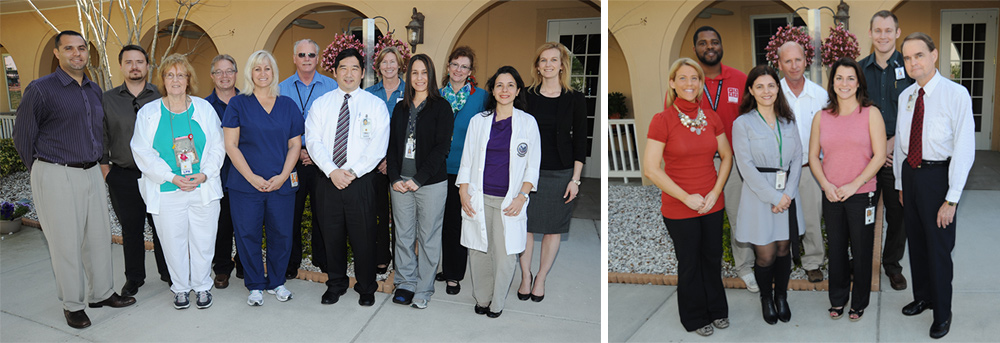 The Comprehensive Pain Center at James A. Haley Veteran’s Hospital in Tampa, FL, continues to serve as the Veteran Administration’s (VA) premier pain treatment center for veterans and active duty military personnel while remaining at the forefront in innovative pain research initiatives. The program serves more than 7,200 patients annually, most in outpatient (5,200) and integrated care outpatient pain programs (1,100). Services and programs have expanded significantly since the program received a 2007 CCOE Award, partly in response to the broad needs of returning Operation Enduring Freedom/Operation Iraqi Freedom/Operation New Dawn personnel. Current services include intensive interdisciplinary inpatient and outpatient Commission on Accreditation of Rehabilitation Facilities–accredited pain rehabilitation; outpatient medical management and psychological consultation and treatment; hospital-wide inpatient pain consultation; specialty pain clinic treatment (including headache clinics); integrated interventional medicine treatment; primary care–based pain consultation and treatment; and two innovative programs to identify and treat pain and pain-related comorbidities.
The Comprehensive Pain Center at James A. Haley Veteran’s Hospital in Tampa, FL, continues to serve as the Veteran Administration’s (VA) premier pain treatment center for veterans and active duty military personnel while remaining at the forefront in innovative pain research initiatives. The program serves more than 7,200 patients annually, most in outpatient (5,200) and integrated care outpatient pain programs (1,100). Services and programs have expanded significantly since the program received a 2007 CCOE Award, partly in response to the broad needs of returning Operation Enduring Freedom/Operation Iraqi Freedom/Operation New Dawn personnel. Current services include intensive interdisciplinary inpatient and outpatient Commission on Accreditation of Rehabilitation Facilities–accredited pain rehabilitation; outpatient medical management and psychological consultation and treatment; hospital-wide inpatient pain consultation; specialty pain clinic treatment (including headache clinics); integrated interventional medicine treatment; primary care–based pain consultation and treatment; and two innovative programs to identify and treat pain and pain-related comorbidities.
A wide range of specialists from endocrinology to cardiology routinely are consulted regarding medical comorbidities. Staff also works closely with the VA’s national polytrauma rehabilitation centers to manage pain issues among those with the most severe combat injuries.
Recent program innovations include the systemwide incorporation of the program’s Pain Outcomes Questionnaire measure into VA electronic medical records, an Accreditation Council for Graduate Medical Education medical pain fellowship that is seeking approval to add a second year of required training, designation as the VA’s national pain team training site, and establishment of the first VA-funded postdoctoral clinical psychology training program specializing in pain psychology. As system leaders in the provision of pain care, program personnel routinely serve as consultants to the VA, Department of Defense, and community healthcare systems.
CCOE Award reviewers commented, “This program has made impressive efforts to establish evidence-based specialized programs for specific groups of veterans,” and “This program has taken the leading role within the VA system in training providers from multiple disciplines in evidence-based pain management.”
United Back Care
Redmond, WA; Everett, WA; Puyallup, WA
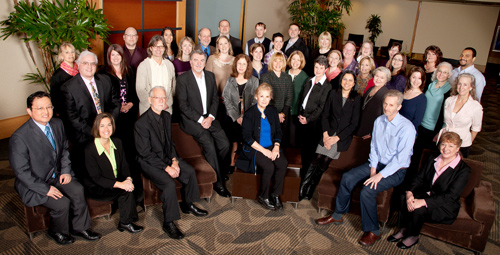 United Back Care (UBC) has offered its pain management services as a freestanding, unaffiliated program for the last 28 years. It is the only center in Washington to offer multiple locations (three) and telemedicine to allow the broadest-possible access in Washington State, serving more than 1,000 outpatients through its programs each year. UBC’s pain management program includes physical/occupational therapy, psychology, medicine, biofeedback, and vocational counseling. The program is 4 weeks in duration for 6 hours daily. A specialized complex regional pain syndrome program and medical and psychological pain management consultations are offered as well. When appropriate, UBC coordinates care for targeted spinal or joint injections or surgery.
United Back Care (UBC) has offered its pain management services as a freestanding, unaffiliated program for the last 28 years. It is the only center in Washington to offer multiple locations (three) and telemedicine to allow the broadest-possible access in Washington State, serving more than 1,000 outpatients through its programs each year. UBC’s pain management program includes physical/occupational therapy, psychology, medicine, biofeedback, and vocational counseling. The program is 4 weeks in duration for 6 hours daily. A specialized complex regional pain syndrome program and medical and psychological pain management consultations are offered as well. When appropriate, UBC coordinates care for targeted spinal or joint injections or surgery.
UBC’s physician serves in a medical advisory role in assisting lawmakers in Washington state redesign pain management treatment guidelines and protocols for safe medication use. UBC staff provide training and education to local employers and claims professionals on prevention and management of industrial injuries. UBC’s Opioid Elimination Program combines medical and psychological expertise to help opioid-dependent patients achieve a safe opioid taper.
UBC also provides community reintegration services and coordinates communication with patients’ employers and physicians to transition patients back into their workplace, home, and community in a safe and supported manner. Individualized services include resources for finding appropriate work, low or no cost English-as-a-second-language classes, housing, and low-cost healthcare and medication coverage. A monthly Family Support Group with UBC’s psychologists assists past and present patients and their families in the ongoing management of chronic pain and its impact on life, work and wellness.
UBC staff is actively involved in research and publication of peer-reviewed articles. One CCOE Award reviewer made note of UBC’s research activities, saying, “Clinicians have published nine papers since 2006; this is exemplary for a private practice.”
UBC also provides community reintegration services and coordinates communication with patients’ employers and physicians to transition patients back into their workplace, home, and community in a safe and supported manner. Individualized services include resources for finding appropriate work, low/no cost English-as-a-second-language classes, housing, and low cost healthcare/medication coverage.
UBC staff is actively involved in research and publication of peer-reviewed articles. One CCOE Award reviewer made note of UBC’s research activities, saying, “Clinicians have published nine papers since 2006; this is exemplary for a private practice.”
Chronic Pain Rehabilitation Program, Neurological Center for Pain, Cleveland Clinic
Cleveland, OH
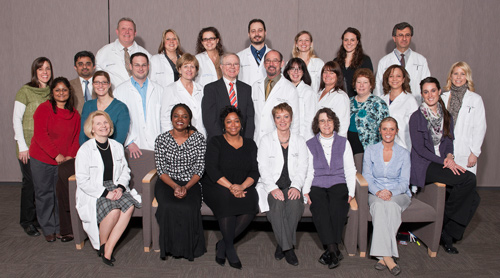 As a part of the Cleveland Clinic, the Chronic Pain Rehabilitation Program (CPRP) has access to consultation from some of the world’s leading experts in all fields of medicine and surgery. Specialists are consulted on an as-needed basis; a goal of the Chronic Pain Rehabilitation Program, however, is to decrease patient reliance on medical care for chronic pain. In that regard, consults are kept to a minimum and patients are not admitted to the program if other treatment options exist. This program serves more than 1,800 patients annually (1,200 outpatients).
As a part of the Cleveland Clinic, the Chronic Pain Rehabilitation Program (CPRP) has access to consultation from some of the world’s leading experts in all fields of medicine and surgery. Specialists are consulted on an as-needed basis; a goal of the Chronic Pain Rehabilitation Program, however, is to decrease patient reliance on medical care for chronic pain. In that regard, consults are kept to a minimum and patients are not admitted to the program if other treatment options exist. This program serves more than 1,800 patients annually (1,200 outpatients).
New developments are rapidly incorporated into the program’s treatment model. Unique staffing and expertise enable simultaneous management of pain and addiction. Outcomes data acquired at admission, discharge, 6 months, and 12 months have been collected on more than 2,500 patients. Outcome studies demonstrate marked, sustained improvements in pain, function, mood, and substance use. These data have contributed to numerous scientific presentations, poster presentations, and publications.
The program expanded services during the last 18 months to improve perioperative pain care via direct patient care and offers pain-related education to neurologists and neurosurgeons.
In response to the increased need for pain and addiction treatment, the CPRP has developed a substance abuse education track. Although not a chemical dependency program, the CPRP uses the expertise of staff trained in the diagnosis and treatment of chemical dependency. The CPRP has a strong regional stature, as evidenced by the fact that 49% of its patients live beyond the program’s seven-county area, and about one-third of patients travel from outside of Ohio.
CCOE reviewers of this program say, “This is a nationally renowned program for pain rehabilitation with a great physical rehabilitation and behavioral orientation,” and “This is an innovative program for patients with chronic pain who are dependent on addictive substances; this is a state-of-the-art rehab center for patients with chronic pain.”
